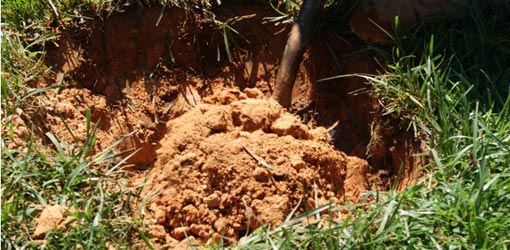how to find your septic tank
If your home uses a septic tank to dispose of waste water, it's important to know how to keep it in proper working order. Here are the basics you need to know to maintain the septic tank system for your home.

A concrete septic tank ready to be installed.
How a Septic Tank Works
A septic tank consists of a large, underground tank with an inlet for the drain pipe coming from your house, and an outlet going to the field lines buried in the yard. The tank allows solid waste to settle out and begins the decomposition process using the natural action of anaerobic bacteria.
Baffles in the tank retain the solid material while allowing liquid to flow into perforated field lines buried in the yard. As it soaks into the soil, the action of aerobic bacteria complete the process of breaking down any remaining waste material.
How to Find the Location of Your Septic Tank
The first step is to determine the location of the septic tank in your yard so it can be inspected and serviced. Septic tanks are usually located at least five feet away from the house with the top buried up to several feet below ground.
Here are some tips on how to locate your septic tank:

Using a camera to find a septic tank.
- A plat of your land (available from your county environmental office) should show the location of the septic tank in your yard.
- Often the general location of the tank and field lines will be evident by greener grass or lush vegetation in the yard.
- If you're still not sure of the location of the septic tank in your yard, a video camera can be inserted in a drain to track the distance to the tank.
- Once you know the general location of your septic tank, a probing device—such as a thin metal rod—is used to find the top of the buried tank. Take care when probing to keep from damaging drain pipes, field lines, sprinkler systems, or buried utility lines.

Probing to locate the top of a septic tank.
When to Pump Out a Septic Tank
A septic tank should be pumped out every three to five years on average, depending upon the size of the tank and the number of occupants in the house. If you experience drainage problems—including bathtubs that are slow to drain or toilets that tend to back up after flushing—contact a reputable sewage contractor at the first sign of trouble, and limit your water use until the problem has been diagnosed and resolved.

Digging up a septic tank to pump and clean it out.
Septic Tank Dos and Don'ts
Follow these tips to maintain your septic tank system and keep it working properly:
- Once you've found your septic tank, record the location for future reference.
- Have your septic tank inspected regularly.
- Pump out your septic tank every three to five years.
- Use biodegradable toilet paper that breaks down easily.
- Conserve water to limit the amount that goes into the tank.
- Never put grease or harsh chemicals—such as solvents, bleach, drain cleaners, pesticides, gasoline, and paint—down a drain or toilet.
- Do not put non-biodegradable items—including dental floss, disposable diapers, kitty litter, condoms, female hygiene products, facial tissue, and cigarettes—down a drain or toilet.
- Do not build or pave on or near a septic tank or field lines.
- Avoid planting trees or shrubs on or near a septic tank or field lines.
- Do not locate a vegetable or herb garden on or near a septic tank or field lines.
- Call a reputable septic tank company if your drains show signs of backing up or draining slowly.

Pumping out a septic tank.
If regular septic tank maintenance is performed, and precautions are taken to keep your system working properly, your system will provide many years of trouble free service.
Dee Massey is employed by Hulsey Environmental & Plumbing Services, Inc. of Gainesville, Georgia. More information is available on their website at www.hulseyenvironmental.com.
how to find your septic tank
Source: https://todayshomeowner.com/how-to-maintain-your-septic-tank/
Posted by: shoremillort56.blogspot.com

0 Response to "how to find your septic tank"
Post a Comment